A workshop and projects post.
In 2 recent posts i wrote about the first of my workshop projects in which i built a very simple rolling tool rack for my inside/outside projects. That project was the first time that i tried deliberately to get a working structure together very quickly and with that was the first time i used ‘Gorilla’ brand clear glue and pins for the small parts and glue/screw for the larger components. Two of my regular readers then asked about my experience of using Gorilla glue and in one of those post replies there were some comparative comments about epoxy so i thought that what i would do is a practical post about my experiences with PVC woodworking glue compared to epoxy resin.
Then this month i also had several other projects ‘on the bench’ and on the boat such that in one day alone i used : PVA woodworking glue, PVC glue, Epoxy resin, adhesive sealant (Siko-bog clone) and had a horrible session inside the boat with contact adhesive…..the real glue-sniffers paradise stuff !. At the end of that session i was not only high as a kite but really did have sticky fingers and spent most of the night peeling the bits of glue of my hands : mind you that could just have been me still hallucinating from the glue !. The contact adhesive job, by the way, was to add some deckhead insulation in the form of cheap camping mats and that needed that form of glue. I had forgotten just how nasty a job that can be having to apply the contact glue overhead….like extremely runny and fumy snot !
When i came to do the epoxy work this week i then had a total ‘doh’ moment when i moved the crate containing the resin, hardener and the additive powders. The lid can’t have been on the resin tin properly because it fell over in the crate and liberally soaked into the cardboard additive tubs….so on a wet Sunday i had to dash into town and buy some plastic cereal containers to transfer the powders into. The crate, by the way, is still sat there because i can’t clean it out and haven’t found a way of disposing of it yet.
Tonight, as i write the post edit, it’s very late o-clock by the way, i have just come in from the workshop where i have been making a mounting pad/spacer for the mizzen mast. That job is due to me moving the mizzen mast aft and sideways out from the companionway. I made the pad from 4 layers of 1 inch structural ply that we had left from the bathroom project, initially glued together with Gorilla glue, but had to coat it tonight with epoxy. That’s the very odd looking object ooozing Gorilla-glue snot all over the vice by the way. Tomorrow i should be mounting that if all goes well with an adhesive sealant similar to Sikaflex.
The second part of the genesis of this post goes back to when i was working out how i was going to do the essential woodworking projects for Inanda. I knew that i was going to have to laminate and then fasten in some 20 or more new partial frames to replace the old cracked ones. I sort-of knew that the frames would probably be made from thin slices of oak steamed, bent and glued together on a laminating jig….i also kind-of knew that oak and epoxy aren’t completely compatible according to some boatbuilders. Then, when i met boatbuilder Nick Gates he very kindly gave me his time in explaining how they did that job in his workshop and that they routinely use a PVC glue for many woodworking projects such as laminating new frames.
As most of you will know by now that project never happened but it was good practice to do the basic research and try to solve some of the practical problems that i would have faced.
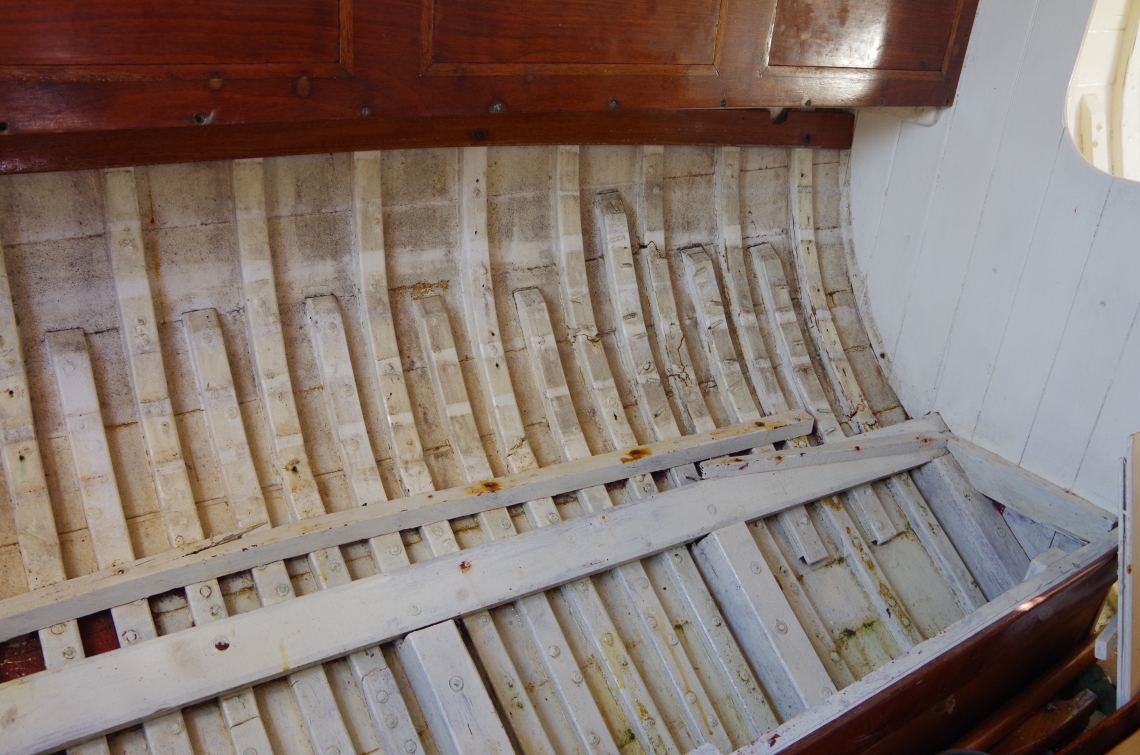
The great thing for me is that when it comes to this stuff i really am a complete noob so i don’t assume to have any knowledge, merely a little bit of experience so far with epoxy resin, and that it’s a very good exercise for me to write about what i have found out so far : if you will the writing of the post is a learning exercise in itself.
I have to admit that i possibly have the wrong temperament to own and work on a classic wooden boat even though i love the look and feel of wooden boats. With Inanda i knew that i wanted to change so many things about her that she wouldn’t have ended up as a Deben 4 tonner any more and i also felt that at her age she needed a much more careful and sympathetic owner than me. I also fully admit to being a full-on quick and dirty epoxy bodge-artist although ‘quick’ i am not : just dirty !
As a lead-in to this post i have recently completed 2 practical projects : one with epoxy resin and the second with PVC ‘Gorilla glue. The 2 projects were the Wanigan for Inanda using epoxy and then the toolstand using PVC glue. I did also complete 2 field repairs aboard Inanda while i was in Wareham using epoxy as that short break in the weather was both very warm and dry. The Wanigan is now the only part of Inanda that i still have and it’s doing great service as our car-camping food crate. One of my winter projects for WABI”’ will be to make a custom cold food/icebox and that will most likely be built in ply/epoxy but a lighter version than the first one and with a lot more insulation.
The wanigan…epoxy fillet construction and a few screws.

So, part 1, lets take a look at epoxy.
My main experience with epoxy resin was in finishing a half built ply/epoxy/glass Wharram catamaran and since then doing small repairs and modifications most often in plywood and using epoxy as the glue, laminating agent and coating/waterproofing. When i had to do the post flooding refit of my Frances 26 i had to make a new mast step, new sole boards, new engine bearers, new electrics box and new icebox. Most of that had to be done in-situ or on the dock.
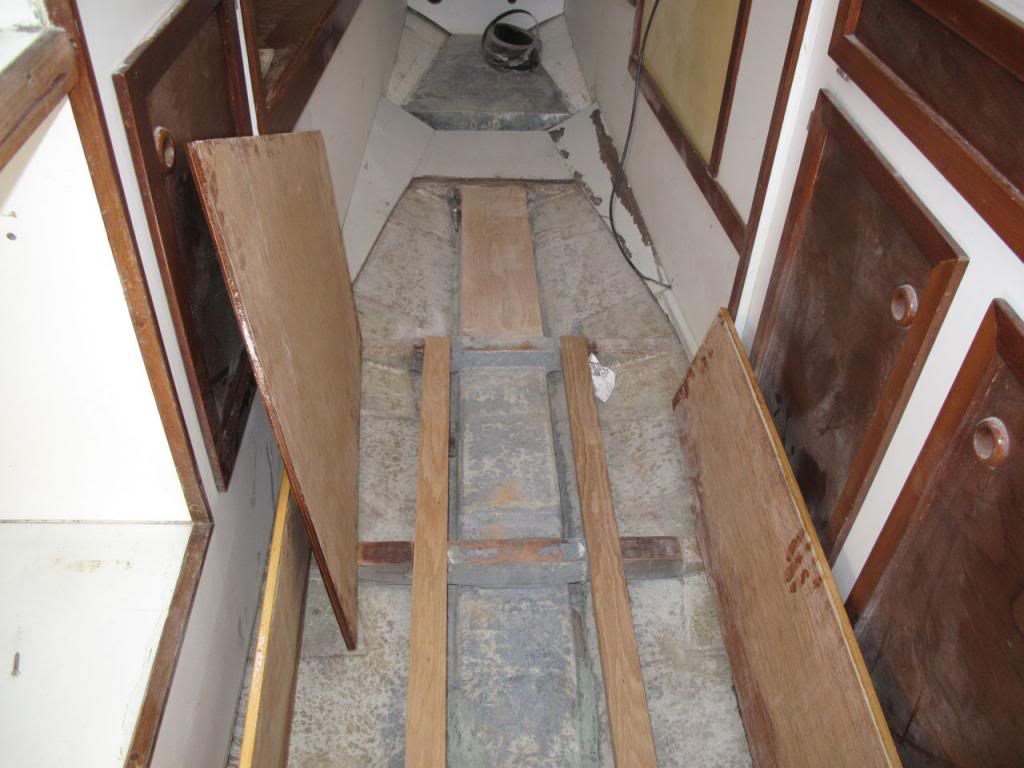
Ok, so lets start talking about epoxy resin.
To the best of my knowledge there are 2 main manufacturers of epoxy products available in the UK : West system and SP systems. They both work on the same resin/hardener ratio and use very similar additives to turn the mixed resin into glues and fillers. One of the main points here is that mixed but un-thickened resin is only of any use for pre wetting joints and for laminating glass fibre cloth to plywood. To make a glue mix or filleting mix needs several different powder additives.
1.Cost. Epoxy resin does now seem to be a very expensive product. I had to buy new resin and hardener this year and at least one new tub of microfibres to make a glue mix. A combination pack (A pack) of 1 litre of resin and 200ml of hardener comes in at around £40 locally but in addition needs several other products to make it work. Tubs of microfibres and low density/high density filler come in at around £17 a tub and i reckon that most boatbuilders will need 2 additives at minimum.
One of the obvious comparisons i wanted to do in this post is to estimate the cost of doing similar jobs in different glues. It’s easy to calculate the cost of a job done with PVC glue, say even Gorilla brand but not so easy to calculate for epoxy. The reason for that is that as well as the base cost of the glue we also have to add in the cost of the additives and accessories.
In addition to the resin and hardener most projects will also need : microfibres, low or high density fillers, colloidal silica, a pump set and or syringes, mixing pots, mixing sticks, brushes ,gloves and ideally a mask or respirator. I found that a basic set up to do one glueing and coating project, the wanigan for example, would have cost me around £80 allowing for resin/hardener, one tub of microfibres, one of low density filler and accesories : pots/sticks/gloves/syringes etc. Obviously that set-up would then do several projects and it is possible to buy smaller amounts of resin although it is hard to buy small amounts of the additives unless they are very small amounts in a pre-made repair kit.
As a very crude estimate lets say we do quite a large glueing job that takes 100 mls of resin plus hardener thus 120 mls total. Well that’s easy because we know that will cost £4 for the resin and hardener. As a very crude estimate we would also need a quantity of microfibres for a straight glue job but also need low density filler or filleting mix if we were making an epoxy-fillet joint. Again crude but i estimate that the cost of the additives increases the cost by about a quarter so lets say £5 for that job.
As a comparison a 250ml bottle of Gorilla glue bought locally costs me about £12 (although i can find it on the internet down to about £9 for the same amount) therefore £48 per litre so initially the glue works out slightly more expensive but doesn’t need any additives and is used straight from the bottle. I now think that i tend to have much less wastage with the PVC glue because i don’t have to estimate how much resin and hardener i need plus a little bit, making up small amounts of resin just doesn’t seem to work well and almost always has high wastage of unused glue.
The cost of doing a large build in wood reinforced fibre (WRP/FRP) is now significant just for the resin and additives. At the end of the post, for reference, i will list some current prices for resin and additives. *
2.The safety of elves. Epoxy resin, more specifically it’s hardener and the part-cured polymer is allergenic ie that i can and does cause an allergic reaction in some people. It’s also very toxic in it’s part cured state. I only have a mild skin reaction but the stuff does tend to give me a headache when i am using it a lot. Of particular note is the semi-cured ‘green’ resin which must not be sanded at that stage of cure. I happen to think but can’t prove that i react more strongly to epoxy+wood dust when i get it on my skin if that is at all sweaty and that is then worse if i have done a lamination or epoxy and glass tape joint. When i am working with epoxy resin i do get through a whole shed load of gloves because i find it best to swap out gloves pretty quickly so that i don’t dab the mixed resin all over the workshop, the tools and my clothes.
3.Working conditions. This is now the greatest problem for me with my cool, often cold, and damp workshop. Epoxy definitely works best in a narrow temperature range for the resin but also really needs the parts being glued to be at a good working temperature as well and crucially to be very dry.
I won’t quote the working temperature and curing times here because most readers will be familiar with the problem. Right now i wouldn’t be able to complete a glue job using epoxy in my own workshop because it’s far too cold and possibly the wood could well have a too high moisture content. In past projects done in winter (or wet) conditions my practice has been to bring everything indoors for several days before glueing-up and even then to pre-warm the parts for several hours first.
The opposite problem can also occur that when the combination of mixed resin and parts is too high that the glue can set far too quickly to work with or exotherm in the pot….i have actually had a pot of mixed resin ‘go critical’ from the additional warmth of my hands ! The additional problems with epoxy for me at least is that i find it very messy, i have to change gloves at almost every stage so that i don’t spread it around and it’s very messy on tools particularly the screwdrivers i tend to use when using the glue/screw technique to hold parts together. I have also destroyed several clamps that have got ‘glued-up’.
4.Epoxy….what is it good for ? Ok. so…it’s expensive, temperature and moisture critical , allergenic, potentially toxic and messy to use so is it any good or in any way better than any other glue ? Firstly then i think that epoxy resin + fibres and/or fillers is a very effective product for building with mainly plywood and then backed up with glass cloth laminating or glass cloth taped joints. It does seem to produce very strong joints even when those joints aren’t exact or clamped up firmly and it definitely does have a gap filling property. As i understand it epoxy/wood joints don’t do so well in strong sunlight and wet to dry cycles which will happen a lot on a boat. According to several sources including our man Nick there are several timbers which aren’t compatible with epoxy and that includes oak. I do like and use the epoxy-fillet method of construction quite a bit , i guess because i learnt that technique early on when i finished the Wharram cat.
Simple plywood boxes made with epoxy fillets only. On the left is the new switch panel box and on the right is the model/pattern for the stainless steel version of the mizzen mast mounting block.
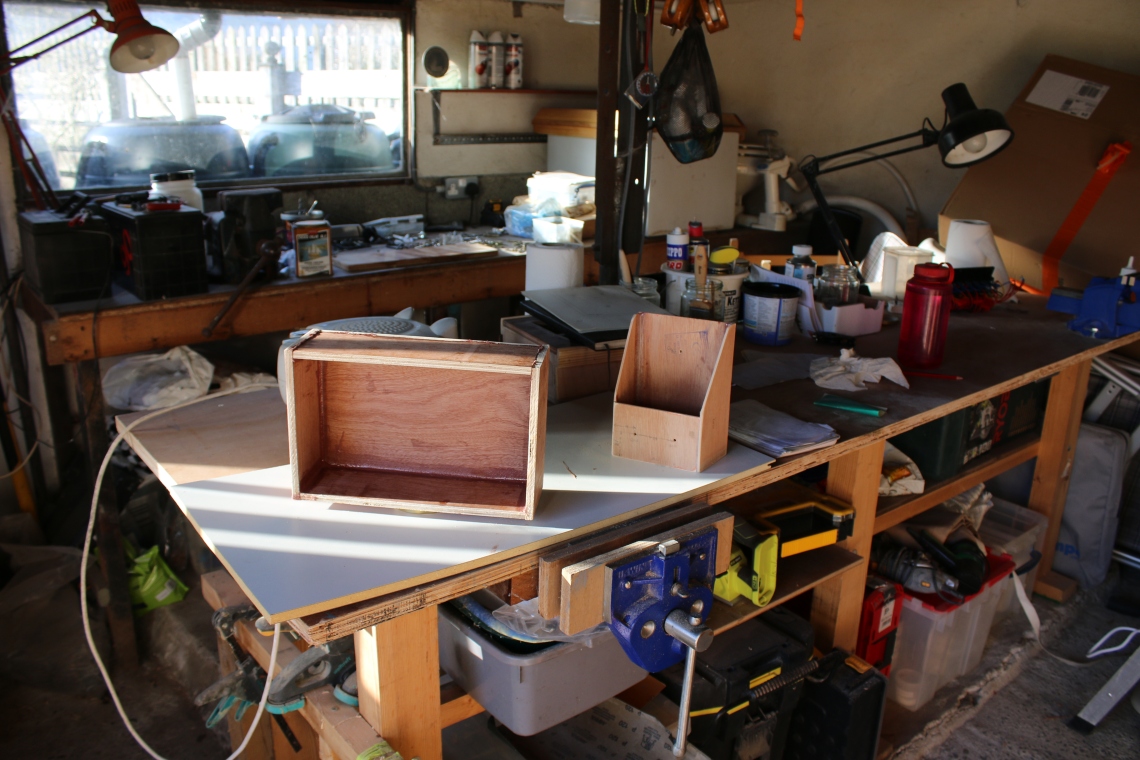
It does seem to be the best solution, that i know of, for glueing a plywood bulkhead into a plywood skin or edge/end glueing a plywood box together as i did with the wanigan project and getting a waterproof joint. That job though only works very well with a 2 stage glue process in which the end grain is wetted out with mixed resin before applying a thickened glue mix. I particularly benefit from the mating parts not needing a very low tolerance fit and high clamping pressures, essentially that i can get away with slightly sloppy joints and only having to initially hold parts together lightly. I particularly like epoxy fillet joints when i am making boxes such as the wanigan or the similar food storage crates for the Frances.
Alongside the fact of epoxy allowing me to bodge my way through projects i can and do end up with seemingly strong structures that can then be made completely watertight with epoxy and glass cloth covering. As far as i know epoxy and glass cloth is the only compatible technique for making a watertight structure. Secondarily epoxy resin + fillers once coated with some form of ultraviolet protection does make an effective surface repair and filler material.
On Inanda i had to do some surface repairs to the aft face of the Douglas fir mast where the gaff jaws had chewed away at the surface. I found that epoxy resin + low density filler was a very close match with the wood colour and protected the damaged fibres until i could get the boat home, at which time my plan was to cover each position for the gaff-jaw with a glass cloth protective layer.
A particularly effective use of epoxy resin is to bond glass cloth onto timber, most commonly that is the technique for building ply/glass hulls which are then stable and waterproof. Right now i need to do some small glass/epoxy coverings on my currrent sprit-booms project but i just can’t get the workshop warm enough or the materials both warm and dry. I might just about be able to do that job if i construct an ‘oven’ around the sprits and pre-warm the glue.
To actually work with epoxy in the workshop at this time of year is a bit of a faff : i have just been doing several projects that really needed epoxy. First i have to sit the epoxy cans in warm water so that the resin comes up to near skin temperature, at the same time i have to get the parts really warm and thoroughly dry. Once together i then have to construct a kind of temporary oven around the work-piece and run a heater at just the right distance and temperature to set the resin without it cooking-off or the wood de-gassing heavily. The opposite approach is that with the gorilla glue it doesn’t seem anything as like as much temperature critical and also needs moisture in the wood to start to set……it is just as messy to work with though.
PVC Gorilla glue.
The mizzen mast support/spacer block…..glue foaming nicely !
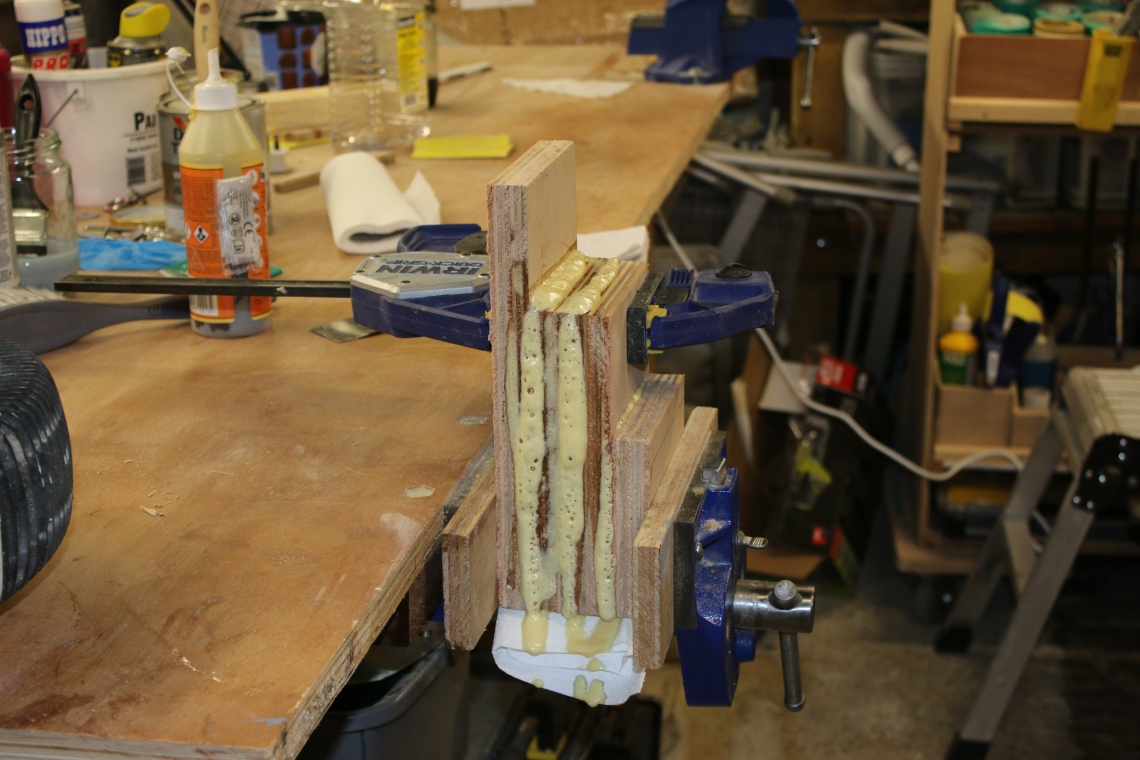
So, lets stop me bitching about how difficult epoxy resin is and instead move on to talking about PVC ‘Gorilla’ glue.
As i mentioned earlier it was boatbuilder Nick Gates whom i met while i was in Emsworth with ‘Inanda’ that turned me on to PVC glue for wooden boat projects. Now, i don’t think Nick uses ‘Gorilla’ brand glue and i don’t remember which brand he says he uses although he does have several different PVC glues from the same manufacturer but which each have different working/curing times, i think from just 5 minutes up to a couple of hours. It would be unfair and unreasonable to make comment about the glues that Nick uses when my only experience so far has been with ‘Gorilla’ brand PVC glue.
Had i continued with the Inanda project i would almost certainly have bought some very fast and very slow cure PVC glues as i would have had several different working requirements, for example i would have needed a longer working time glue for making the laminated frames and then some fast cure glue for jobs that need setting up very quickly. As it is i have been able to buy the glue that i have been experimenting with in small quantities at first and just experimented with the one brand.
As i said above the Gorilla glue has worked out at about the same cost as buying epoxy resin except that it doesn’t need all the additives and extras such as mixing pots, loads of gloves, mixing sticks and so on. Also unlike epoxy i can buy the glue in very small quantities and although much more expensive per ml that way i have been able to keep a small bottle of the stuff on the boat, one in the toolbag, one in the car and a much larger one in the workshop.
For small jobs that just need one piece glueing to another there is almost no comparison with epoxy in the ease and convenience of using PVC glue. The application is instant….just squeeze some out of the bottle, spread it a little and pin/screw or clamp up the work piece. It definitely needs higher clamping pressure than a similar job with epoxy as the glue seems to expand and ‘foam up’ during it’s cure. Whereas with an epoxy fillet joint such as i have just been doing with the switchboard box, where all i have to do is tape the parts together and make the fillets, with PVC the parts do need holding together firmly. The required pressure doesn’t seem as high as say resorcinol glues which i don’t use but does need to be firm.
For the mizzen mast mounting block above i had to apply glue to 3 faces , spread that around and then use a combination of the workshop vice and one clamp to apply firm pressure. I probably used just a little bit too much glue and the pieces do seem to want to slide over each other but that’s always the problem i find with making pieces like that and would have been a similar problem had i used epoxy. The great benefit though is that even with the glue cold and the pieces cool to cold the whole thing cured in about 40 minutes and was ready to clean up at about an hour.
It is messy stuff to work with as it foams up during it’s cure and i haven’t found any way of cleaning a job as i go along other than scraping off the excess glue and residual glue ‘foam’ with a scraper or my epoxy mixing sticks. I also have to be aware of where the excess glue is going but that’s mainly just me being a messy worker !. The normal clean-up does seem a lot easier than a similar operation with epoxy in that the waste glue ‘foam’ is easy to remove with a scraper and isn’t as hard as cured epoxy which can be harder than the surface wood fibres it is soaked into.
What i have very little information on so far is how strong a bond the PVC glue makes in various types of wood. The general impression i get is that the glue line is stronger than the wood fibres so a well prepared and glued joint should be strong. Where the glue doesn’t work as well as epoxy is that it has no capacity to form a fillet joint which is one form of jointing that i tend to use a lot. I have seen, but can’t find again, one report of a mast, glued up with Gorilla brand glue, breaking at a scarph joint i think.
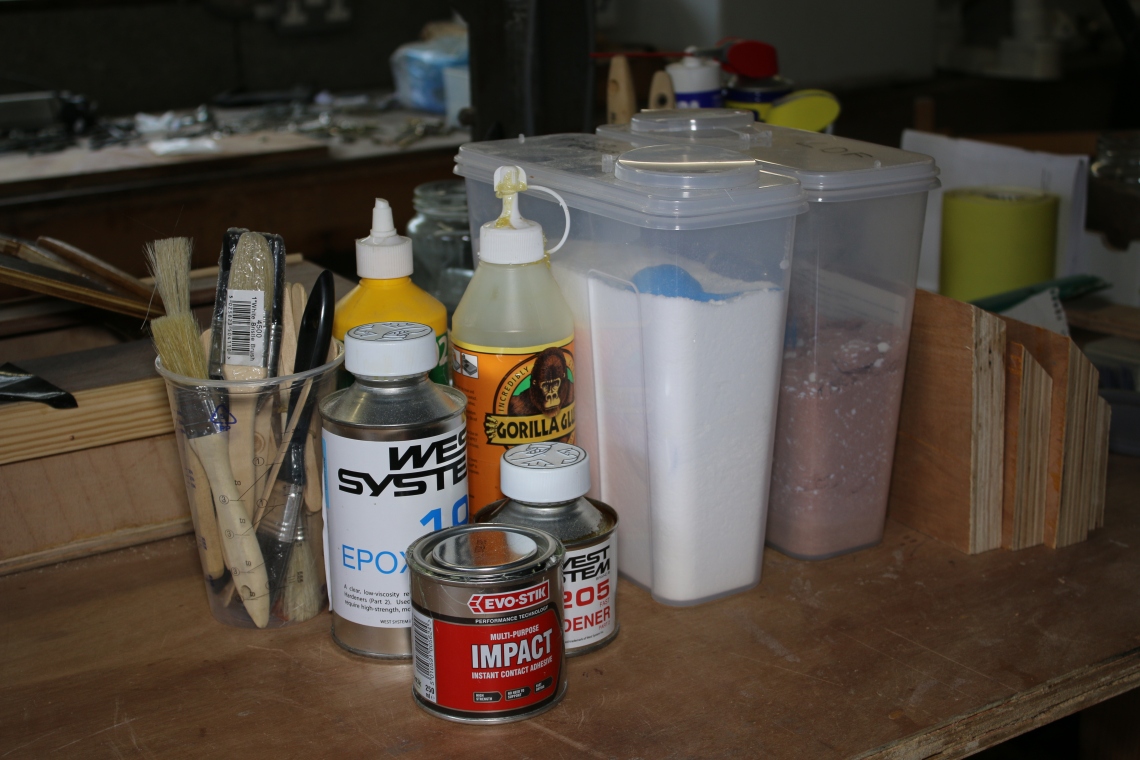
So, can i come to any conclusion about which glue is better ?.
My answer is ‘not really’ because i don’t have anything like enough experience with PVC glue yet, especially in critical applications. I think that both glues…..and all the other adhesives i use each have a place. I will continue to carry a small epoxy repair kit on the boat because it can work as an effective GRP repair and i now carry some Gorilla glue and some clamps. Having said that i also carry some of the miniature (toothpaste sized) tubes of genuine Sikaflex and for temporary fixes that gets used the most.
If i decide to go ahead with the wooden masts project i am more likely to use epoxy for that because it’s gap filling quality is kinder to my slightly sloppy joints, equally it’s the only thing that i know of which i can make fillet joints with or bond glass fibre cloth th plywood with.
The PVC Gorilla glue now definitely has a place in the workshop as it seems to be an effective glue, isn’t as temperature and humidity critical as epoxy and doesn’t need any mixing…..which is much more economical for the many small glueing operations i have to do during a job.



Good post Steve, It must be us getting old everything seems expensive ..
I haven’t used the Gorilla glue as yet so I will pick some up and try it, any idea how waterproof is it long term ?
Been using various alternatives to Stika mess with good results so far, currently using a Bostic product for bonding all the ally bits on a camping trailer I use the ‘sausages’ in an air powered gun for economy and much easier to dispense, it stops when you take your finger off the trigger rather than continuing to ooze out.
LikeLike
If you don’t mind, I’d like to comment on your post. It’s based on 40 experience working on wood boats.
In this internet age, with too much information available, and people looking for quick and easy answers, it is easy to get bamboozled. Epoxy is not the only solution and West System is not the only supplier.
The best, absolutely best glue or oak is Resorcinol. It’s the only glue to work for underwater joints. Epoxy doesn’t.
Polyester resin works just as well and costs about 1/4 as much.
Barry Thompson
>
LikeLike
I hope that something i have achieved in the post is to demonstrate 2 things : first that i don’t know very much but am willing to spend the time finding out/researching and that maybe there isn’t a single perfect all-round glue. I did point out in the post that i know of 2 suppliers of epoxy and have used both.
LikeLike
Steve Cascamite/Polymite seems to have some of the properties of epoxy (a strong gap filler) but with the advantages of PVC (low clamping pressure and a good working time/temperature range) plus easy clean-up with very hot water and a toothbrush. It’s also waterproof and suitable for the marine environment as people have used it to build small wooden boats. This from the reviews:
“First used this glue as an apprentice Joiner in 1956 in the staircase shop in a major contractors woodworking factory. Been using it ever since. Owned two dinghy’s glued up with cascamite. Sailed for years salt and fresh water and the glue never failed.”
More importantly it’s relatively cheap, especially as you can mix up just the right amount for the job.
https://www.axminster.co.uk/cascamite-powdered-resin-wood-glue-ax21688?sel=400023
Worth a look perhaps?
LikeLike
Steve, this stuff might be worth a try:
https://www.axminster.co.uk/cascamite-powdered-resin-wood-glue-ax21688?sel=400023
LikeLike
Steve and Stephen. I have used cascamite glue over the years with good effect, though one is now more focused on epoxy. So, thanks for the reminder, and must get some in for up and coming projects. Epoxy is still probably the best for sealing the finished product, and with suitable UV inhibitors.
LikeLike
Steve and Stephen. I have used cascamite type glue over the years with good effect. Easy to use and avoids a mess, and of course effective. I needed the reminder, thanks, as epoxy seems to have taken over the world. Would be good to have your project input.
LikeLike
A postscript to the above… Thanks for the heads up re Axminster. I saw in their catalogue some disposable brushes; 36 in 3 sizes. I ordered two packs and they arrived in 48 hours. They are just the job for what is being discussed. Thanks guys.
LikeLike
I get through lots of brushes….bought a pack of disposable ones down at marine bazaar. Funnily enough if i am doing a quick paint job, say oil based primer, i will often use a disposable brush now rather than try and clean a nice one.
LikeLike